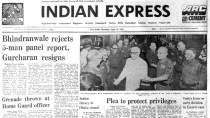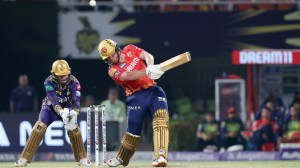- India
- International
Unfathomable greatness
An incurable romantic, poetry suited Begum Akhtar’s temperament.
 An incurable romantic, poetry suited Begum Akhtar’s temperament.
An incurable romantic, poetry suited Begum Akhtar’s temperament.
Ghazal, that death-sustaining widow,/ sobs in dingy archives, hooked to you./ She wears her grief, a moon-soaked white,/ corners the sky into disbelief.
The late Agha Shahid Ali began writing his tribute to Begum Akhtar when he returned from her funeral, 40 years ago this month. Last week, on October 7, the 100th anniversary of her birth, Shubha Mudgal offered haazri at Begum Akhtar’s mazaar in Pasand Bagh, Lucknow. Understandably, she felt intimidated and decided not to sing any ghazals or other compositions associated with the late singer. The space of ghazal gayaki left empty by Begum Akhtar stays empty.
It is easy to predict that this space will stay empty forever. Begum Akhtar was the last of the singers in an illustrious line of women musicians who were steeped equally in music and poetry. While all tawaifs had brought music to poetry, Begum Akhtar brought poetry to music. Both came to her instinctively. The tawaifi tradition drew upon the knowledge and skills of the best music and dance ustads. Many poets who aspired for wider fame, too, were willing to be patronised by these women. Scholars were employed to teach them poetry. Training in deportment, etiquette, style, conversation, etc were imparted in-house. Begum Akhtar was the poster girl for the tawaifi music tradition and all its attendant sophistications.
Set to music and dance, the ghazal had found wider space in the 20th century because of films and their music. It was through these three-minute renditions of the ghazal that Begum Akhtar had first acquired fame. But it was in her longer renditions, either on All India Radio or later on long and extended playing records, that it became evident she not only had a magical voice but also a masterly command of music. However, it was her instinctive relationship to language that set her apart from all others.
For instance, the way she would split words or combine them into musical phrases shows how comfortable she was with Urdu’s poetic idiom. This musical comfort level with the language also marked out some of her younger contemporaries like Mehdi Hasan, Iqbal Bano and Farida Khanum, and is sadly missing from most other singers.

Begum Akhtar knew she was belittled as a singer by critics and some other musicians because she did not sing khayal (though she recorded a few chhota khayals early in her career) . She was labelled as a light classical singer, which did not seem to bother her except when she was pointedly reminded of it by the establishment. For instance, she was hurt when the Sangeet Natak Akademi took its time in bestowing its annual award on her.
Begum Akhtar was never known as a dancer, though she had been trained to dance. From early on in life she had stuck to her passion — poetry. She opted out of films and preferred to perform in personalised mehfils where she was at liberty to weave her musical and romantic magic over her audience. An incurable romantic, poetry suited her temperament and it is this that made her mehfils such a place to aspire to and be in. Even her best known devotional thumris addressed to Krishna are romantic, with the attendant emotions of love, longing, pain, separation, jealousy, etc. She could as easily be naughty as in the dadra, “Hamri atariya aao sanwariya”. In contrast, her naats in honour of the Prophet are formal and competent but they never made it near the top of the popularity charts of Muslim devotional music anyway.
However, we have been criminally denied access to a large body of her renditions of marsiya and soz, mournful devotional music performed during Muharram. Hidden somewhere in the impenetrable innards of AIR are hours of her renditions of poetry without any musical accompaniment. Without listening to these, Begum Akhtar’s musical greatness has yet to be pegged.
Post 1947, Begum Akhtar was one of the most effective ambassadors for Urdu. She made the poetry of the great, the talented and the popular — Mir, Ghalib, Dagh, Makhdoom, Josh, Faiz, Shakeel and Kaifi — sound even greater when she sang it. So self-assured was she that she would, on impulse, set a ghazal to a raga different from the one she usually sang in. She made Urdu familiar to non-Urdu speakers. It wasn’t surprising, therefore, that M.S. Subbalakshmi turned to her for advice when she decided to sing a Ghalib ghazal. With her passing, the use of Urdu in popular music has consistently declined.
The ghazal, along with its gayaki, has become a victim of the politics of language. Today, when even the Urdu spoken in the 1950s-60s is considered classical, when supposedly informed ghazal audiences don’t notice the mispronunciation of crucial consonants, when listeners are unaware of the mangling of even better-known couplets, the space for the ghazal gayaki has shrunk and been so radically transformed that there is little difference left between ghazal and geet. Hopefully, the media attention to her in this centennial year will bring her music and Urdu poetry back to the attention of music fans.
The writer is a historian.
EXPRESS OPINION
More Explained
Apr 26: Latest News
- 01
- 02
- 03
- 04
- 05










































